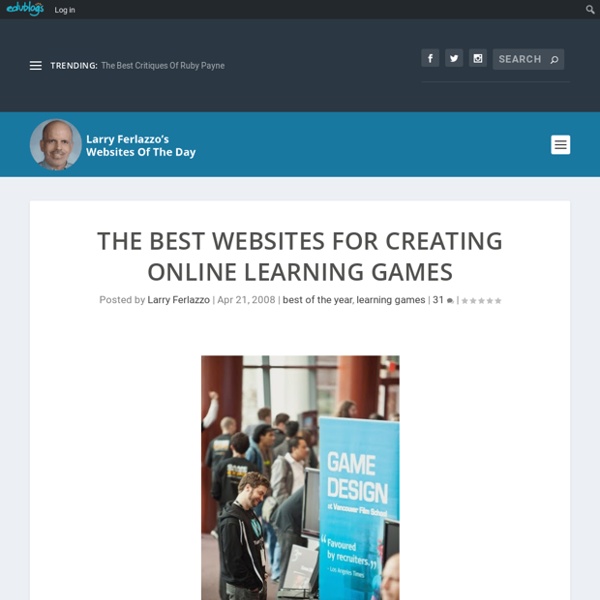The Best Websites For Creating Online Learning Games

http://larryferlazzo.edublogs.org/2008/04/21/the-best-websites-for-creating-online-learning-games/
Related: olgapelaezalvarez
• Oktatás
Short Stories for ESL students
Everybody knows reading is good for language learners, but what do you do with students who aren’t ready for full-length books? Try short stories. Here are 4 fun quick reads that work well with intermediate+ students.
35 ways to introduce your lesson topic – ELT Planning
Are you fed up with using the same old methods to introduce your lesson topic? Look no further! Here are 35 ways to kick off your lesson. How many have you tried? Using an anecdote
Habit formation: 5-minute tips for improving your English
By Sandy Millin In the process I've tried all kinds of different techniques, some of which have worked better than others. As a teacher, I share these with my students, and encourage them to experiment to find what works best for them. This helps them to become more autonomous, as they take control of their language learning by doing what interests them. Regardless of which specific strategies or techniques my students choose to use, the one thing I emphasise is the importance of habit formation. Here's what I tell my students...
5-Minute Film Festival: 7 Video Writing Prompts for Young Authors
National Novel Writing Month (NaNoWriMo) is coming up, but the time is always ripe for encouraging students of every age to write. And how better to pique their interest and power up their pencils (or keyboards!) than with a video writing prompt? Just about any short, intriguing video can be made into a great writing prompt with the addition of a choice question or two, but I've put together a list of favorites discovered around the web. Happy writing! Video Playlist: Video Writing Prompts for the Classroom
Multimedia Resources: No Registration Needed for Students – Nathan Hall
Locating good audio and visual resources for students to use on their multimedia projects can be tricky. It is important to help students navigate the area of attribution and copyright. I have started to collect resources for my students that either don’t require attribution (eg. public domain) or are Creative Commons licensed. All of the resources listed here do not require the students to register or give up personal information to download and use. I am using the following symbols to designate their licensing and usage: ©️ = Attribution needed
How to Use your Phone as a Remote for Google Slides
Wouldn’t you like to be the cool teacher using your mobile as a remote to present your own slides? This is soooo easy that I don’t know why I haven’t tried it before. Before acting cool, you will need to download two things. Don’t worry. They are free.
Going Cashless? – Money and Payments Vocab
If you want to talk with your more advanced students about money, this cashless society lesson plan might be of your interest. It looks into countries that are going cashless, i.e. where people almost only use digital payment methods. The lesson plan includes a lot of vocabulary and speaking tasks. First, students need to revise some vocabulary connected with money, payments and banking. They have to complete sentences with words given.
A Game of Cards to Revise Vocabulary in a Speaking Activity. Effective, Engaging and No-Prep.
I have always liked playing cards. Like about 20 years ago, I used to meet with some friends at the weekend to play cards. We usually met at a cosy old cafe where most of the elderly in my village met to play cards and domino with their buddies.
Dice Cards – An Activity to Encourage Participation
We’ve all seen the different kinds of students that come into our classes. Some students are confident, some students are talkative and some students are reluctant to participate. There is no one reason why a student is reluctant to participate in class. It may be that they are shy, it may be that they have some anxiety about speaking English or it may be they are not particularly interested in English.
Google Classroom Now Has a Random Name Selector
Google Classroom has a new random name selector tool available in the Google Classroom Android app. As announced by Google earlier today the random name selector will randomly pick names from your roster and let you keep track of which students have or have not been called upon. To use the random name selector in the Google Classroom Android app simply open the app, select your class, tap "people" at the bottom of the screen, and then tap the random name selector at the top of the next screen. The random name picker will let you mark a student as absent if he/she isn't in class.
600 free online courses you can take from universities worldwide
If you haven’t heard, universities around the world are offering their courses online for free (or at least partially free). These courses are collectively called MOOCs or Massive Open Online Courses. In the past six years or so, over 800 universities have created more than 10,000 of these MOOCs. And I’ve been keeping track of these MOOCs the entire time over at Class Central, ever since they rose to prominence.
Related:



